A Project of the Hudson River Estuary Program
Compiled and edited by Tom Lake, Consulting Naturalist
Love Our NY Lands
State Lands Belong to All of Us
All New Yorkers and visitors should be able to access, enjoy, and feel welcome on state lands. These lands belong to all of us, our families, and our neighbors. While enjoying these shared spaces, be respectful of other visitors. Share trails, treat people with kindness, and leave things as you found them for others to enjoy. All of us have a responsibility to protect State lands for future generations. For more information, visit DEC's website.
Overview
The Bedford Audubon and Hook Mountain hawk watches saw their migrating raptor numbers improve suggesting the autumn rush is near. Rising salinity in the estuary encouraged young-of-year marine fishes to move upriver. A once-in-twelve-years visiting songbird surprised birders. The late-summer flush of aquatic vegetation out of tidemarshes and tributaries was beginning.
Highlight of the Week
 9/4 – New Paltz, HRM 78: I removed ten saddleback caterpillars today from one small, denuded blueberry leaf from a single plant that I acquired from a local nursery. It is the only one of my 15 blueberry plants that has most of its leaves eaten. The saddleback caterpillar is the larvae form of Acharia stimulea, a species of moth native to eastern North America. I released the caterpillars far from home. Despite their irritating spines and the loss of blueberry leaves, they nevertheless deserve to have a chance at survival. (Photo of saddleback caterpillar courtesy of Roland Bahret) 9/4 – New Paltz, HRM 78: I removed ten saddleback caterpillars today from one small, denuded blueberry leaf from a single plant that I acquired from a local nursery. It is the only one of my 15 blueberry plants that has most of its leaves eaten. The saddleback caterpillar is the larvae form of Acharia stimulea, a species of moth native to eastern North America. I released the caterpillars far from home. Despite their irritating spines and the loss of blueberry leaves, they nevertheless deserve to have a chance at survival. (Photo of saddleback caterpillar courtesy of Roland Bahret)
- Roland Bahret
[The species belongs to the family of slug caterpillars (Limacodidae), most widely known and recognizable for its larvae phase that feeds on a large variety of plants. The larva (caterpillar) is primarily green with brown at both ends and a prominent white-ringed brown dot in the center which resembles a saddle. It has a pair of fleshy horns at both ends. These and most of the rest of the body contain tubercles with hollow spines that, when broken, release an irritating toxin into predators. Contact with the hairs causes a painful, swollen rash (Whitney and Crenshaw 2017).]
Natural History Entries
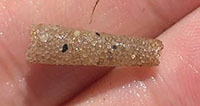 9/2 – Manhattan, New York City: Our Randall’s Island Natural Areas Team went seining along the Harlem River today. Our morning hauls were at Water's Edge Garden where the highlights included Atlantic silverside (high count 265), tautog, bay anchovy, scup (porgy), naked goby, three dozen blue crabs, and many comb jellies all the size of red globe grapes. The river was 75 degrees Fahrenheit (F), the salinity was 27.0 parts-per-thousand (ppt), and the dissolved oxygen (DO) was 5.08 parts-per-million (ppm). 9/2 – Manhattan, New York City: Our Randall’s Island Natural Areas Team went seining along the Harlem River today. Our morning hauls were at Water's Edge Garden where the highlights included Atlantic silverside (high count 265), tautog, bay anchovy, scup (porgy), naked goby, three dozen blue crabs, and many comb jellies all the size of red globe grapes. The river was 75 degrees Fahrenheit (F), the salinity was 27.0 parts-per-thousand (ppt), and the dissolved oxygen (DO) was 5.08 parts-per-million (ppm).
In the afternoon we seined at Little Hell Gate also on the Harlem River. The water was a bit warmer (76 degrees F), less salty (25.0 ppt), with a slightly improved DO (5.24 ppm). The tide was rising quickly limiting us to two hauls. We netted mummichog, silverside, menhaden, blue crabs, and something new, the casing of a trumpet worm (Pectinariidae), also known as the ice cream worm. (Photo of trumpet worm courtesy of Jackie Wu)
- Jackie Wu
[Pectinariids are a family of marine polychaete worms, sessile burrowing tube dwellers, roughly resembling ice cream cones, found in fine-grained sediments. They position the wider end of their tube downward and use their stout golden setae for digging while they use tentacles for sorting the particles which they ingest. These structures can be up to 50 millimeters (mm). (Vinn 2003).]
[Note: One-inch equals 25.4 millimeters (mm)]
 9/3 – Little Stony Point, HRM 55: What a place to be — On a beach in early September with a net in hand and looking into the river to discover the cryptic world of fishes. Strong tides had stirred up the river leaving it the color of coffee-double-cream and rollers from a west wind made our seining an unsettling challenge. Our catch had not changed much in the last few days with Atlantic silverside (63-87 mm) and young-of-year striped bass (72-86 mm) still dominant. The salinity was just a bit over 6.0 ppt leaving us to hope for some new arrivals from the sea. The best we got today, however, was a school of young-of-year Atlantic menhaden (57 mm). (Photo of Atlantic silverside courtesy of Tom Lake) 9/3 – Little Stony Point, HRM 55: What a place to be — On a beach in early September with a net in hand and looking into the river to discover the cryptic world of fishes. Strong tides had stirred up the river leaving it the color of coffee-double-cream and rollers from a west wind made our seining an unsettling challenge. Our catch had not changed much in the last few days with Atlantic silverside (63-87 mm) and young-of-year striped bass (72-86 mm) still dominant. The salinity was just a bit over 6.0 ppt leaving us to hope for some new arrivals from the sea. The best we got today, however, was a school of young-of-year Atlantic menhaden (57 mm). (Photo of Atlantic silverside courtesy of Tom Lake)
- Tom Lake, Phyllis Lake
9/3 – Bedford, HRM 35: Among the 16 south-migrating raptors today at the Bedford Audubon Chestnut Ridge Hawkwatch, osprey was high count with nine. Overall migration was still slow, but we saw a noticeable up-tick in movement especially for osprey. Non-raptor migrants included two monarch butterflies, 18 chimney swifts, ten ruby-throated hummingbirds, and 37 cedar waxwings.
- Richard Aracil, Karen Troche, Pedro Troche
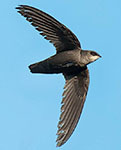 9/4 – Germantown, HRM 108: I was in my yard in late afternoon when I looked up and saw a string of chimney swifts (Chaetura pelagica) heading west. They were quickly joined by many more and soon the sky became peppered with many hundreds. The flight waned but was repeated ten minutes later all heading west. 9/4 – Germantown, HRM 108: I was in my yard in late afternoon when I looked up and saw a string of chimney swifts (Chaetura pelagica) heading west. They were quickly joined by many more and soon the sky became peppered with many hundreds. The flight waned but was repeated ten minutes later all heading west.
I've watched chimney swifts massing to roost but nothing like this — I could not begin to estimate the numbers. Collective nouns for large numbers of chimney swifts include a “screaming frenzy”, and a “swoop.” The latter seemed most appropriate. (Photo of chimney swift courtesy of Michael Hahn)
- Mimi Brauch
9/4 – Hook Mountain, HRM 31: Of the 16 south-migrating raptors at the Hook Mountain Hawkwatch today, osprey was high count with nine. This was an unexpectedly hot and humid day with a lot of haze and very little wind.
- Raimund Miller, Max Miller
9/4 – Bedford, HRM 35: Among the 14 south-migrating raptors today at the Bedford Audubon Chestnut Ridge Hawkwatch, both osprey and broad-winged hawk were high count with four. Non-raptor migrants included 33 chimney swifts, nine ruby-throated hummingbirds, 28 cedar waxwings, and two common nighthawks.
- Richard Aracil, Karen Troche, Pedro Troche
 9/5 – Little Stony Point, HRM 55: We were seining between showers on the last of the down tide. Heavy recent rain up in the watershed had reached us lowering the salinity to 4.5 ppt. A stiff west wind had put a chop on the river that turned to rollers by the time we left, and the current had switched. Our next challenge was finding open slots to seine between groups of holiday beach goers. 9/5 – Little Stony Point, HRM 55: We were seining between showers on the last of the down tide. Heavy recent rain up in the watershed had reached us lowering the salinity to 4.5 ppt. A stiff west wind had put a chop on the river that turned to rollers by the time we left, and the current had switched. Our next challenge was finding open slots to seine between groups of holiday beach goers.
After several hauls and calculating our catch (doing the math) we guessed there was no less than a solid acre of Atlantic silverside (62-92 mm) just off the beach. We also guessed there was a similar number of Atlantic menhaden (60-62 mm). Striped bass were represented by two separate young-of-year cohorts: early-spawned 120-125 mm, late-spawned at 52-58 mm. With a roily surf, it was no surprise that white perch were present feeding on breaker-tossed food like small crustaceans.
We not only shared the beach with holiday revelers, but also a dozen juvenile mallards feasting on duck weed. We gave them their space. These young-of-year ducks had been here with us since late May when they were just fluff. The river was 80 degrees F. (Photo of Atlantic menhaden courtesy of Phyllis Lake)
- Tom Lake, Angel Ordóñez
9/5 – Bedford, HRM 35: Among the 12 south-migrating raptors today at the Bedford Audubon Chestnut Ridge Hawkwatch, broad-winged hawk was high count with three. This was another slow, early-season watch with just a handful of migrating raptors.
Non-raptor migrants included, 50 chimney swifts, 28 cedar waxwings, and a monarch butterfly. At the platform we saw common yellowthroat, two fly-by Cape May warblers, and a spotted lanternfly.
- Richard Aracil, Bill Graham, Gloria Graham, Nadav Snir-Zelniker
 9/6 – Croton Point, HRM 34: The heavy rain softened just in time for a lunch break on the beach in Croton Bay. An osprey and a bald eagle perched in the trees overhead. Today marked the last day of herbicide treatment for the aquatic invasive plant Hydrilla verticillata in the Croton River (DEC’s Croton Hydrilla Control Project). 9/6 – Croton Point, HRM 34: The heavy rain softened just in time for a lunch break on the beach in Croton Bay. An osprey and a bald eagle perched in the trees overhead. Today marked the last day of herbicide treatment for the aquatic invasive plant Hydrilla verticillata in the Croton River (DEC’s Croton Hydrilla Control Project).
A busy season of submersed aquatic plant surveys will begin soon in the Croton River and has already begun for the Hudson River Estuary. But today, the Bay felt like bliss for a mid-day break. (Photo of Hydrilla verticillata courtesy of NYS Department of Environmental Conservation)
-Nicole White
[Hydrilla verticillata It is native to Asia, Africa, and Australia. Hydrilla is invasive in the United States following its aquarium-release in the 1950s-1960s into waterways in Florida. Hydrilla can be controlled by herbicides, as well as by grass carp, itself an invasive species in North America. (Langeland 1996)]
*** Fish of the Week ***
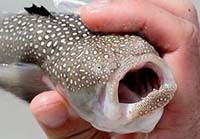 9/6 – Hudson River Watershed: Fish-of-the-Week for Week 186 is the northern stargazer (Astroscopus guttatus), number 205 (of 236), on our Hudson River Watershed List of Fishes. If you would like a copy of our list, e-mail: trlake7@aol.com 9/6 – Hudson River Watershed: Fish-of-the-Week for Week 186 is the northern stargazer (Astroscopus guttatus), number 205 (of 236), on our Hudson River Watershed List of Fishes. If you would like a copy of our list, e-mail: trlake7@aol.com
The northern stargazer, also known as the "electric" stargazer, is the only member of its family (Uranoscopidae) in the watershed. Their common name "stargazer" is an example of clever nomenclature; similarly, our common loon (Gavia immer) is known in Europe as the Great Northern Diver. Very appropriate choice in both instances
They are a marine species found from New York south to Virginia. In the estuary, they are classified as a temperate marine stray and are uncommonly caught in research and education gear. Most recently, July 14, 2020, at Dobbs Ferry (river mile 23), DEC Region 3 Hudson River Fisheries Unit staff, using a 200 x 10-foot beach seine, caught a young-of-year (30 mm) northern stargazer. As an adult, the northern stargazer can grow to 22 inches and weigh 20 lb.
Ichthyologist C. Lavett Smith called the northern stargazer "a bizarre fish." They have been fashioned by natural selection (chock full of favored traits) in the mode of the oyster toadfish and the goosefish. They have a nearly vertical mouth surrounded by fringed lips. Much of their body mass is in their head and they will eat pretty much whatever they can fit in their huge mouth. They bury themselves in the sand with their eyes and mouth sticking out just enough, aimed skyward (star-ward) and wait for prey. When something appealing swims by, the stargazer uses its large mouth to create a vacuum to suck it in.
Northern stargazers have an organ in their head that can deliver an electric charge that can stun prey and perhaps ward off predators. They can also produce a noticeable shock to anglers grasping their head to remove a fish hook, something to which I can attest. Their genus name, Astroscopus, comes from Latin as one that "aims at the stars." Their trivial name, guttatus, comes from Latin as "speckled," as in raindrops. (Photo of Northern stargazer courtesy of Cat Smith)
- Tom Lake
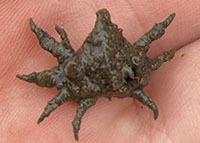 9/6 – Manhattan, HRM 1-2: Our Hudson River Park staff checked our research gear (pots and traps) that we deploy off Piers 40 and 26 as part of our ongoing fish ecology survey. At Pier 40, our crab pots caught two adult oyster toadfish (260, 270 mm) and a male blue crab. A minnow trap exceeded expectations with a young-of-year black sea bass (70 mm) and an oyster toadfish (40 mm). We also found several mud crabs, a spider crab, and innumerable sea squirts. 9/6 – Manhattan, HRM 1-2: Our Hudson River Park staff checked our research gear (pots and traps) that we deploy off Piers 40 and 26 as part of our ongoing fish ecology survey. At Pier 40, our crab pots caught two adult oyster toadfish (260, 270 mm) and a male blue crab. A minnow trap exceeded expectations with a young-of-year black sea bass (70 mm) and an oyster toadfish (40 mm). We also found several mud crabs, a spider crab, and innumerable sea squirts.
At Pier 26, a crab pot caught an impressive adult blackfish/tautog (230 mm). Our four minnow traps all had a full house catching four black sea bass (40-70 mm). Mud dog whelks, juvenile spider crabs, comb jellies, mud crabs, and sea squirts added to the collection. (Photo of spider crab courtesy of Zoe Kim)
- Zoe Kim
[The common spider crab (Libinia emarginata) is found on all types of bottom and depths along the Atlantic Coast from Nova Scotia to the Gulf of Mexico. Their common name, “spider,” comes from their legs that can be three times as long as their carapace width. Tom Lake]
9/7 – Bedford, HRM 35: Among the nine south-migrating raptors today at the Bedford Audubon Chestnut Ridge Hawkwatch, bald eagle was high count with four. This was another day with just a handful of migrating raptors. Non-raptor migrants included, 28 chimney swifts, three ruby-throated hummingbirds, and a monarch butterfly.
- Richard Aracil
9/7 – Hook Mountain, HRM 31: The 15 clearly south-migrating raptors at the Hook Mountain Hawkwatch today were all osprey. Others not deemed as migrants included black vulture, turkey vulture, red-tailed hawk, and two ravens.
- Tom Fiore
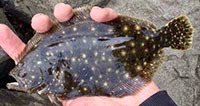 9/7– Yonkers, HRM 18: Our staff at the Sarah Lawrence Center for the Urban River at Beczak was eager to get back in the river after a brief respite. The results of our five seine hauls today were remarkable. While high count went to moon jellyfish (118), they were just the background to an adult summer flounder (230 mm), a rather uncommon species off our beach. Also in the net were Atlantic menhaden, Atlantic silverside, blue crabs (20-40 mm), grass shrimp, and comb jellies. The river was 81 degrees F, the salinity was 14.5 ppt, and the DO was low at 5.0 ppm. (Photo of summer flounder courtesy of Anthony Ferino) 9/7– Yonkers, HRM 18: Our staff at the Sarah Lawrence Center for the Urban River at Beczak was eager to get back in the river after a brief respite. The results of our five seine hauls today were remarkable. While high count went to moon jellyfish (118), they were just the background to an adult summer flounder (230 mm), a rather uncommon species off our beach. Also in the net were Atlantic menhaden, Atlantic silverside, blue crabs (20-40 mm), grass shrimp, and comb jellies. The river was 81 degrees F, the salinity was 14.5 ppt, and the DO was low at 5.0 ppm. (Photo of summer flounder courtesy of Anthony Ferino)
- Jason Muller, Katie Lamboy, Leah Traub
[The standard research measurement for blue crabs (mm) is point-to-point, laterally, across their carapace.]
 9/8 – Little Stony Point, HRM 55: We were seeing the late-summer release of aquatic vegetation from mashes and wetlands (tidewater’s version of falling autumn leaves). A sustained west wind had created an aquatic garden in the surf that included duck weed, wild celery, Eurasian water chestnut, water milfoil, pondweed, and others. Hauling our seine was frustrating; it would take more time to clear the net afterwards than we had spent pulling the net. 9/8 – Little Stony Point, HRM 55: We were seeing the late-summer release of aquatic vegetation from mashes and wetlands (tidewater’s version of falling autumn leaves). A sustained west wind had created an aquatic garden in the surf that included duck weed, wild celery, Eurasian water chestnut, water milfoil, pondweed, and others. Hauling our seine was frustrating; it would take more time to clear the net afterwards than we had spent pulling the net.
When the bag came in, we waded through the greenery and thorns to find hundreds of Atlantic menhaden as well as young-of-year striped bass (57-77 mm) and bay anchovies (45-58 mm). We found it disturbing at not finding any young-of-year river herring or American shad, all missing since late June. The river was 79 degrees F, and the salinity had fallen to 4.0 ppt. (Photo of striped bass courtesy of Tom Lake)
- Tom Lake, Phyllis Lake
9/8 – Bedford, HRM 35: Among the 117 south-migrating raptors today at the Bedford Audubon Chestnut Ridge Hawkwatch, broad-winged hawk was high count with 51. This was our first substantial movement of the season with nice diversity as well. We also had our first broad-winged hawk "kettle" of the season.
We were in excellent company as we were joined by Pedro Troche, John Askildsen, and Kevin McGrath, all of whom were a great help with finding birds. John Askildsen is a veteran at this hawkwatch from when it first began in the late 1970's. It was interesting and fun to hear his stories of birding here over the years.
Non-raptor migrants included 25 monarch butterflies, 17 common nighthawks, 62 chimney swifts, 18 ruby-throated hummingbirds, and 14 cedar waxwings. There were a few fly-by warblers in the morning, but a single Cape May was the only one I could identify.
- Richard Aracil, John Askildsen, Kevin McGrath, Pedro Troche
[“Kettle” is a birding term that describes an aggregation of birds, usually raptors or vultures, often circling overhead in warm, rising thermals. It is the circular movement of the group that appears like a cauldron of birds being stirred by the wind, thus a kettle. While kettles can occur almost any time of the year, they are particularly common during fall migration. Tom Lake]
9/8 – Hook Mountain, HRM 31: Of the 32 south-migrating raptors at the Hook Mountain Hawkwatch today, broad-winged hawk was high count with 16. One of the two migrating red-tailed hawks had Harlan's hawk type plumage. An immature red-tailed hawk followed a bald eagle at a respectable distance, cautiously harassing it. Non-raptor observations: Among dragonflies were black saddlebags, spotted skimmer; butterflies included black swallowtail, tiger swallowtail, red-spotted purple, Horace's duskywing, cabbage white, and monarchs (3).
- Trudy Battaly, Drew Panko, Raimund Miller
[Harlan's red-tailed hawk (Buteo jamaicensis harlani) is a subspecies of the red-tailed hawk. They breed from central Alaska to northwestern Canada, with the largest number of birds breeding in the Yukon, western Alaska, and north-central British Columbia. Harlan's hawk winters from Nebraska and Kansas to Texas and northern Louisiana, with the occasional rare bird found as far east as Tennessee (Liguori and Sullivan 2010).]
9/8 – Yonkers, HRM 18: Buoyed by yesterday’s excellent catch, our staff at the Sarah Lawrence Center for the Urban River at Beczak made five more hauls today. While moon jellyfish continued to be high count (545), Atlantic silverside made a nice showing as well (106). Other fish included young-of-year striped bass and Atlantic menhaden, as well as an American eel (350 mm). Other invertebrates included blue crabs and comb jellies. The river was 77 degrees F, the salinity was seasonally high at 15.1 ppt, and the DO continued to be critically low at 5.0 ppm.
- Jason Muller, Leah Traub
[The dissolved oxygen levels (DO) in the Tappan Zee can be variable. However, the shallow edges of the bay will heat up in summer and warm water potentially holds less DO since it has trouble staying in solution. DO can be at its lowest value during low tides, our favored time to seine. As Jay Muller points out, 5.0 parts-per-million is a critical bottom threshold. But since fish are mobile, short bursts of low DO can be tolerated. The sweet spot for fish is from 6-11 ppm. Margie Turrin]
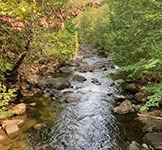 9/9 – Tahawus, HRM 310: Hiking up the red trail approach to Mount Marcy from the trailhead at Tahawus has always had a magical air to it. I’m sure the feeling comes from the countless memories of all-season treks up this trail with family and friends. 9/9 – Tahawus, HRM 310: Hiking up the red trail approach to Mount Marcy from the trailhead at Tahawus has always had a magical air to it. I’m sure the feeling comes from the countless memories of all-season treks up this trail with family and friends.
The trail runs along Calamity Brook, one of a several cascading downstream from Lake Tear-of-the-Clouds at the foot of Mount Marcy. At Tahawus, the brook meets the Hudson River, the first such designation that it will keep for the 300 miles to the sea. Despite the state-wide summer drought, Calamity Brook was flowing at its usual, in-a-hurry, late summer pace creating whitewater as it plunged over rocks the size of refrigerators.
Except for the occasional raven, the forest was quiet, quiet enough to hear the brook if you listened. The signature sound of the Adirondack wilderness are the calls of the common loon. However, another sound that conjures up the magic of the High Peaks is the echoing “ank ank ank” call of the red-breasted nuthatch, Roger Tory Peterson’s “tiny tin horn.” (Photo of Calamity Brook courtesy of Tom Lake)
- Tom Lake
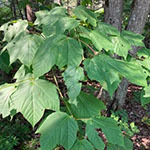 9/9 – Boreas River, HRM 294: I stopped along Route 28N at the Boreas River to walk the blue trail, an easy 1.8-mile loop along the Boreas River. It is along this trail in winter where the fragrance of balsam fir will have you humming Christmas Carols. It is also a walk among striped maples, an elegant tree that indigenous people referred to as “green stick.” This is a trail where I occasionally see black-backed woodpeckers (Picoides arcticus) and one showed itself today, a male, across the river hanging on the side of a pine. Raucous ravens, looking to be the size of eagles but with more verve, dominated the air. Locals hold ravens in high esteem suggesting they keep the hawks on their toes. (Photo of striped maple courtesy of Tom Lake) 9/9 – Boreas River, HRM 294: I stopped along Route 28N at the Boreas River to walk the blue trail, an easy 1.8-mile loop along the Boreas River. It is along this trail in winter where the fragrance of balsam fir will have you humming Christmas Carols. It is also a walk among striped maples, an elegant tree that indigenous people referred to as “green stick.” This is a trail where I occasionally see black-backed woodpeckers (Picoides arcticus) and one showed itself today, a male, across the river hanging on the side of a pine. Raucous ravens, looking to be the size of eagles but with more verve, dominated the air. Locals hold ravens in high esteem suggesting they keep the hawks on their toes. (Photo of striped maple courtesy of Tom Lake)
- Tom Lake
 9/9 – Orange County, HRM 50: A beautiful osprey landed in a nearby tree just above the Highland Falls Wastewater Treatment facility this afternoon. An adult Atlantic menhaden was clutched its talons. We've seen them flying carrying fish, but this one was the first one we could see feeding from our deck. (Photo of osprey courtesy of Tim Judd) 9/9 – Orange County, HRM 50: A beautiful osprey landed in a nearby tree just above the Highland Falls Wastewater Treatment facility this afternoon. An adult Atlantic menhaden was clutched its talons. We've seen them flying carrying fish, but this one was the first one we could see feeding from our deck. (Photo of osprey courtesy of Tim Judd)
- Tim Judd, Nancy Judd
[This is the season when osprey migrate. It is very common for them to stop along the way to fuel up. Some are heading deep into South America. Tom Lake]
9/9 – Bedford, HRM 35: Among the 83 south-migrating raptors today at the Bedford Audubon Chestnut Ridge Hawkwatch, sharp-shinned hawk and American kestrel were each high count with 23. The pace was slower than yesterday, but still a decent flight. We counted a few high, cruising immature red-tailed hawks that looked convincingly like migrants.
Non-raptor migrants included eleven monarch butterflies, 99 chimney swifts, eight ruby-throated hummingbirds, four common nighthawks, and two non-migrating spotted lanternflies.
- Richard Aracil, Pedro Troche
 9/9 – Croton Point, HRM 34.5: Michelle Brigman, Roger Pare, and Rob Amendola were walking at Croton Point this evening when they came upon an unusual bird. Michelle Brigman took many photos and sent a couple of them to me to see if our identification would be confirmed by Cornell's Merlin Bird ID app. It was confirmed as a yellow-headed blackbird. I went to the park at sunrise on 9/10 and was fortunate to catch a distant view of it for several minutes. (Photo of yellow-headed blackbird courtesy of Roger Pare) 9/9 – Croton Point, HRM 34.5: Michelle Brigman, Roger Pare, and Rob Amendola were walking at Croton Point this evening when they came upon an unusual bird. Michelle Brigman took many photos and sent a couple of them to me to see if our identification would be confirmed by Cornell's Merlin Bird ID app. It was confirmed as a yellow-headed blackbird. I went to the park at sunrise on 9/10 and was fortunate to catch a distant view of it for several minutes. (Photo of yellow-headed blackbird courtesy of Roger Pare)
- Steve Rappaport
[The previous Westchester County sighting was on January 11, 2010, a bird that spent good part of December 2009 into January 2010 at Pruyn Sanctuary, Town of New Castle. Larry Trachtenberg]
9/9 – Hook Mountain, HRM 31: Of the 128 south-migrating raptors at the Hook Mountain Hawkwatch today, American kestrel was high count with 35. A special note on red-tailed hawks: There were a number that might possibly have been migrants, and I counted a few as such. Their appearances included some that remained at very high elevations. However, there also were apparent locals among the red-tails that were going up to extreme heights, and a few that also made incredible lengthy long dives down into the surrounding hills and trees.
- Eugene Gardner, Jeff Berman, Susanna Perlov
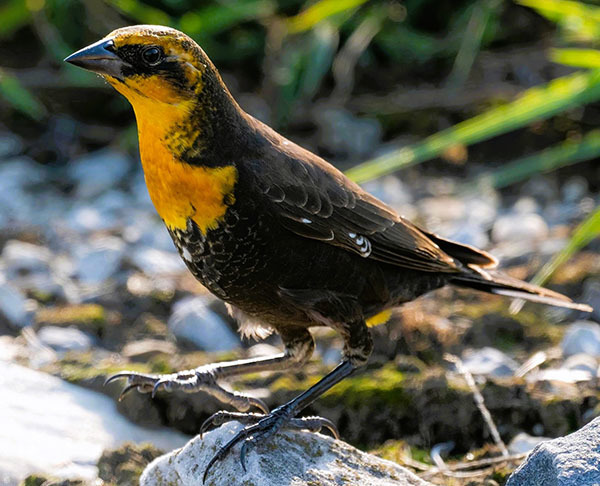
Summer 2022 Natural History Programs and Events
Come Canoeing with the National Estuarine Research Reserve
Free public canoe program in the tidal marshes of the Hudson River estuary. Learn about the wildlife and dynamic system of the tidal wetlands. Information and registration link:
https://2022-nysdec-canoeprogram.eventbrite.com
September 18, 11:00 a.m. 22nd Hudson River Ramble
Hudson Highlands State Park
Little Stony Point, Route 9D, Cold Spring
Hudson River Education
Teachers and students will enjoy our new Hudson River K-12 Unit of Study. This carefully curated group of lesson plans, arranged by topic and/or grade, brings together great learning tools developed by the DEC and dozens of estuary partners.
Hudson River Miles
The Hudson is measured north from Hudson River Mile 0 at the Battery at the southern tip of Manhattan. The George Washington Bridge is at HRM 12, the Tappan Zee 28, Bear Mountain 47, Beacon-Newburgh 62, Mid-Hudson 75, Kingston-Rhinecliff 95, Rip Van Winkle 114, and the Federal Dam at Troy, the head of tidewater, at 153. The tidal section of the Hudson constitutes a bit less than half the total distance – 315 miles – from Lake Tear of the Clouds to the Battery. Entries from points east and west in the watershed reference the corresponding river mile on the mainstem.
To Contribute Your Observations or to Subscribe
The Hudson River Almanac is compiled and edited by Tom Lake and emailed weekly by DEC's Hudson River Estuary Program. Share your observations by e-mailing them to trlake7@aol.com. To subscribe to the Almanac (or to unsubscribe), use the links on DEC's Hudson River Almanac or DEC Delivers web pages.
Useful Links
National Oceanic and Atmospheric Administration online tide and tidal current predictions are invaluable when planning Hudson River field trips. For real-time information on Hudson River tides, weather, and water conditions from sixteen monitoring stations, visit the Hudson River Environmental Conditions Observing System website.
DEC's Smartphone app for iPhone and Android is now available at New York Fishing, Hunting & Wildlife App. The HuntFishNY app, includes the new Tackle Box feature, which provides a one-stop location for nearly all State fishing regulations, waterbodies, State-operated fishing access sites, stocking information, and other useful features like photos to help identify fish likely found in a certain river, lake, or stream. Tackle Box allows users to search for waterbodies by name or by panning and zooming. In addition, the new 'navigate' feature gives users driving directions to the boating access site of their choice. The Tackle Box also includes an offline feature that allows anglers to use it when cell service is not available.
|


 9/4 – New Paltz, HRM 78: I removed ten saddleback caterpillars today from one small, denuded blueberry leaf from a single plant that I acquired from a local nursery. It is the only one of my 15 blueberry plants that has most of its leaves eaten. The saddleback caterpillar is the larvae form of Acharia stimulea, a species of moth native to eastern North America. I released the caterpillars far from home. Despite their irritating spines and the loss of blueberry leaves, they nevertheless deserve to have a chance at survival. (Photo of saddleback caterpillar courtesy of Roland Bahret)
9/4 – New Paltz, HRM 78: I removed ten saddleback caterpillars today from one small, denuded blueberry leaf from a single plant that I acquired from a local nursery. It is the only one of my 15 blueberry plants that has most of its leaves eaten. The saddleback caterpillar is the larvae form of Acharia stimulea, a species of moth native to eastern North America. I released the caterpillars far from home. Despite their irritating spines and the loss of blueberry leaves, they nevertheless deserve to have a chance at survival. (Photo of saddleback caterpillar courtesy of Roland Bahret) 9/2 – Manhattan, New York City: Our Randall’s Island Natural Areas Team went seining along the Harlem River today. Our morning hauls were at Water's Edge Garden where the highlights included Atlantic silverside (high count 265), tautog, bay anchovy, scup (porgy), naked goby, three dozen blue crabs, and many comb jellies all the size of red globe grapes. The river was 75 degrees Fahrenheit (F), the salinity was 27.0 parts-per-thousand (ppt), and the dissolved oxygen (DO) was 5.08 parts-per-million (ppm).
9/2 – Manhattan, New York City: Our Randall’s Island Natural Areas Team went seining along the Harlem River today. Our morning hauls were at Water's Edge Garden where the highlights included Atlantic silverside (high count 265), tautog, bay anchovy, scup (porgy), naked goby, three dozen blue crabs, and many comb jellies all the size of red globe grapes. The river was 75 degrees Fahrenheit (F), the salinity was 27.0 parts-per-thousand (ppt), and the dissolved oxygen (DO) was 5.08 parts-per-million (ppm). 9/3 – Little Stony Point, HRM 55: What a place to be — On a beach in early September with a net in hand and looking into the river to discover the cryptic world of fishes. Strong tides had stirred up the river leaving it the color of coffee-double-cream and rollers from a west wind made our seining an unsettling challenge. Our catch had not changed much in the last few days with Atlantic silverside (63-87 mm) and young-of-year striped bass (72-86 mm) still dominant. The salinity was just a bit over 6.0 ppt leaving us to hope for some new arrivals from the sea. The best we got today, however, was a school of young-of-year Atlantic menhaden (57 mm). (Photo of Atlantic silverside courtesy of Tom Lake)
9/3 – Little Stony Point, HRM 55: What a place to be — On a beach in early September with a net in hand and looking into the river to discover the cryptic world of fishes. Strong tides had stirred up the river leaving it the color of coffee-double-cream and rollers from a west wind made our seining an unsettling challenge. Our catch had not changed much in the last few days with Atlantic silverside (63-87 mm) and young-of-year striped bass (72-86 mm) still dominant. The salinity was just a bit over 6.0 ppt leaving us to hope for some new arrivals from the sea. The best we got today, however, was a school of young-of-year Atlantic menhaden (57 mm). (Photo of Atlantic silverside courtesy of Tom Lake) 9/4 – Germantown, HRM 108: I was in my yard in late afternoon when I looked up and saw a string of chimney swifts (Chaetura pelagica) heading west. They were quickly joined by many more and soon the sky became peppered with many hundreds. The flight waned but was repeated ten minutes later all heading west.
9/4 – Germantown, HRM 108: I was in my yard in late afternoon when I looked up and saw a string of chimney swifts (Chaetura pelagica) heading west. They were quickly joined by many more and soon the sky became peppered with many hundreds. The flight waned but was repeated ten minutes later all heading west. 9/5 – Little Stony Point, HRM 55: We were seining between showers on the last of the down tide. Heavy recent rain up in the watershed had reached us lowering the salinity to 4.5 ppt. A stiff west wind had put a chop on the river that turned to rollers by the time we left, and the current had switched. Our next challenge was finding open slots to seine between groups of holiday beach goers.
9/5 – Little Stony Point, HRM 55: We were seining between showers on the last of the down tide. Heavy recent rain up in the watershed had reached us lowering the salinity to 4.5 ppt. A stiff west wind had put a chop on the river that turned to rollers by the time we left, and the current had switched. Our next challenge was finding open slots to seine between groups of holiday beach goers. 9/6 – Croton Point, HRM 34: The heavy rain softened just in time for a lunch break on the beach in Croton Bay. An osprey and a bald eagle perched in the trees overhead. Today marked the last day of herbicide treatment for the aquatic invasive plant Hydrilla verticillata in the Croton River (DEC’s Croton Hydrilla Control Project).
9/6 – Croton Point, HRM 34: The heavy rain softened just in time for a lunch break on the beach in Croton Bay. An osprey and a bald eagle perched in the trees overhead. Today marked the last day of herbicide treatment for the aquatic invasive plant Hydrilla verticillata in the Croton River (DEC’s Croton Hydrilla Control Project). 9/6 – Hudson River Watershed: Fish-of-the-Week for Week 186 is the northern stargazer (Astroscopus guttatus), number 205 (of 236), on our Hudson River Watershed List of Fishes. If you would like a copy of our list, e-mail: trlake7@aol.com
9/6 – Hudson River Watershed: Fish-of-the-Week for Week 186 is the northern stargazer (Astroscopus guttatus), number 205 (of 236), on our Hudson River Watershed List of Fishes. If you would like a copy of our list, e-mail: trlake7@aol.com 9/6 – Manhattan, HRM 1-2: Our Hudson River Park staff checked our research gear (pots and traps) that we deploy off Piers 40 and 26 as part of our ongoing fish ecology survey. At Pier 40, our crab pots caught two adult oyster toadfish (260, 270 mm) and a male blue crab. A minnow trap exceeded expectations with a young-of-year black sea bass (70 mm) and an oyster toadfish (40 mm). We also found several mud crabs, a spider crab, and innumerable sea squirts.
9/6 – Manhattan, HRM 1-2: Our Hudson River Park staff checked our research gear (pots and traps) that we deploy off Piers 40 and 26 as part of our ongoing fish ecology survey. At Pier 40, our crab pots caught two adult oyster toadfish (260, 270 mm) and a male blue crab. A minnow trap exceeded expectations with a young-of-year black sea bass (70 mm) and an oyster toadfish (40 mm). We also found several mud crabs, a spider crab, and innumerable sea squirts. 9/7– Yonkers, HRM 18: Our staff at the Sarah Lawrence Center for the Urban River at Beczak was eager to get back in the river after a brief respite. The results of our five seine hauls today were remarkable. While high count went to moon jellyfish (118), they were just the background to an adult summer flounder (230 mm), a rather uncommon species off our beach. Also in the net were Atlantic menhaden, Atlantic silverside, blue crabs (20-40 mm), grass shrimp, and comb jellies. The river was 81 degrees F, the salinity was 14.5 ppt, and the DO was low at 5.0 ppm. (Photo of summer flounder courtesy of Anthony Ferino)
9/7– Yonkers, HRM 18: Our staff at the Sarah Lawrence Center for the Urban River at Beczak was eager to get back in the river after a brief respite. The results of our five seine hauls today were remarkable. While high count went to moon jellyfish (118), they were just the background to an adult summer flounder (230 mm), a rather uncommon species off our beach. Also in the net were Atlantic menhaden, Atlantic silverside, blue crabs (20-40 mm), grass shrimp, and comb jellies. The river was 81 degrees F, the salinity was 14.5 ppt, and the DO was low at 5.0 ppm. (Photo of summer flounder courtesy of Anthony Ferino) 9/8 – Little Stony Point, HRM 55: We were seeing the late-summer release of aquatic vegetation from mashes and wetlands (tidewater’s version of falling autumn leaves). A sustained west wind had created an aquatic garden in the surf that included duck weed, wild celery, Eurasian water chestnut, water milfoil, pondweed, and others. Hauling our seine was frustrating; it would take more time to clear the net afterwards than we had spent pulling the net.
9/8 – Little Stony Point, HRM 55: We were seeing the late-summer release of aquatic vegetation from mashes and wetlands (tidewater’s version of falling autumn leaves). A sustained west wind had created an aquatic garden in the surf that included duck weed, wild celery, Eurasian water chestnut, water milfoil, pondweed, and others. Hauling our seine was frustrating; it would take more time to clear the net afterwards than we had spent pulling the net. 9/9 – Tahawus, HRM 310: Hiking up the red trail approach to Mount Marcy from the trailhead at Tahawus has always had a magical air to it. I’m sure the feeling comes from the countless memories of all-season treks up this trail with family and friends.
9/9 – Tahawus, HRM 310: Hiking up the red trail approach to Mount Marcy from the trailhead at Tahawus has always had a magical air to it. I’m sure the feeling comes from the countless memories of all-season treks up this trail with family and friends. 9/9 – Boreas River, HRM 294: I stopped along Route 28N at the Boreas River to walk the blue trail, an easy 1.8-mile loop along the Boreas River. It is along this trail in winter where the fragrance of balsam fir will have you humming Christmas Carols. It is also a walk among striped maples, an elegant tree that indigenous people referred to as “green stick.” This is a trail where I occasionally see black-backed woodpeckers (Picoides arcticus) and one showed itself today, a male, across the river hanging on the side of a pine. Raucous ravens, looking to be the size of eagles but with more verve, dominated the air. Locals hold ravens in high esteem suggesting they keep the hawks on their toes. (Photo of striped maple courtesy of Tom Lake)
9/9 – Boreas River, HRM 294: I stopped along Route 28N at the Boreas River to walk the blue trail, an easy 1.8-mile loop along the Boreas River. It is along this trail in winter where the fragrance of balsam fir will have you humming Christmas Carols. It is also a walk among striped maples, an elegant tree that indigenous people referred to as “green stick.” This is a trail where I occasionally see black-backed woodpeckers (Picoides arcticus) and one showed itself today, a male, across the river hanging on the side of a pine. Raucous ravens, looking to be the size of eagles but with more verve, dominated the air. Locals hold ravens in high esteem suggesting they keep the hawks on their toes. (Photo of striped maple courtesy of Tom Lake) 9/9 – Orange County, HRM 50: A beautiful osprey landed in a nearby tree just above the Highland Falls Wastewater Treatment facility this afternoon. An adult Atlantic menhaden was clutched its talons. We've seen them flying carrying fish, but this one was the first one we could see feeding from our deck. (Photo of osprey courtesy of Tim Judd)
9/9 – Orange County, HRM 50: A beautiful osprey landed in a nearby tree just above the Highland Falls Wastewater Treatment facility this afternoon. An adult Atlantic menhaden was clutched its talons. We've seen them flying carrying fish, but this one was the first one we could see feeding from our deck. (Photo of osprey courtesy of Tim Judd) 9/9 – Croton Point, HRM 34.5: Michelle Brigman, Roger Pare, and Rob Amendola were walking at Croton Point this evening when they came upon an unusual bird. Michelle Brigman took many photos and sent a couple of them to me to see if our identification would be confirmed by Cornell's Merlin Bird ID app. It was confirmed as a yellow-headed blackbird. I went to the park at sunrise on 9/10 and was fortunate to catch a distant view of it for several minutes. (Photo of yellow-headed blackbird courtesy of Roger Pare)
9/9 – Croton Point, HRM 34.5: Michelle Brigman, Roger Pare, and Rob Amendola were walking at Croton Point this evening when they came upon an unusual bird. Michelle Brigman took many photos and sent a couple of them to me to see if our identification would be confirmed by Cornell's Merlin Bird ID app. It was confirmed as a yellow-headed blackbird. I went to the park at sunrise on 9/10 and was fortunate to catch a distant view of it for several minutes. (Photo of yellow-headed blackbird courtesy of Roger Pare)